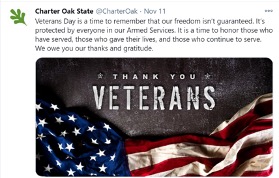Social Media
How Alternative Description Text (Alt -Text) Can Make Social Media Accessible
Include a written description for any images or photos that have content embedded in them or serve a specific purpose. Images add flair to social media posts, making them more attractive, attention grabbing and simpler to understand. Without an image description, a person using a screen reader cannot extract any meaning from the content.

Image Description: A photo of the Eiffel Tower in Paris surrounded by blue skies and clouds on a sunny day with the city and trees in the background.
Writing Image Descriptions
Ask the following questions and combine your answers for the description. Remember to keep the alternative text as succinct as possible - usually one short sentence is all that's needed.
- Who is in the photo? Thousands of runners.
- What are they doing? The runners are at the “Staring Line” preparing to run in the Manchester Road Race.
- Why is this photo being taken? To show the spectacle of the Manchester Road Race, specifically how Main Street, Manchester is closed.

Image Description: Photo of Main Street, Manchester CT closed to vehicles as thousands of runners prepare to start running the Manchester Road Race.
Adding Alternative Text to Social Media Posts

- Twitter - First, enable alt-text within your account settings under "accessibility." Then, before tweeting an image you will receive a prompt that says "add description."
- Facebook - When posting an image, tap "edit photo" and then "add alt-text."
- Instagram - When posting, go to "advanced settings" and then "Write alt-text."
Captioning Videos
Video content should be captioned. Captions are essential for people with deafness and hearing loss, but can benefit everyone - for example, anyone watching a video in a loud environment.
Read about how closed captions can benefit all students.
Captions can be closed or open. Closed captioning can be turned on/off by the user and open captioning are burned into the video.
Camel Case Hashtags
When using hashtags, it is better to use capital letters for each word such #WeAreChampions instead of #wearechampions. This is called Camel Case and by capitalizing each word in the hashtag, it makes it much easier for those who are blind, dyslexic, partially sighted, etc. who are using a screen reader. Screen readers cannot identify individual words in hashtags and if Camel Case is not used, the hashtag will not be accessible.
Emojis and Emoticons
People who use screen readers due to their disability, a descriptions of an emoji will be read aloud such as "raising hands". However, because screen readers read aloud the meta description associated with an emoji, certain description can be confusing to those individuals using a screen reader if multiple emojis are used.
When Using Emojis Do:
- Use emojis sparingly. Dr. Amit Patel, creator of @blinddad_uk, explains how this can be a frustrating user experience: “If there’s lots of emojis together, they get read out as a long sentence: rabbit-dog-pawprints-smileyface-laughingcryingface-thumbsup.”
- Check the meta description (hover over the emoji in the panel of options). The meta descriptions can change across devices and platforms. For example, the house emoji is known as Abandoned House, Old House, Haunted House, and Derelict House depending on where and how it’s viewed by a user. You can also copy emojis from Emoji Keyboard to use in social media posts.
- Put emojis at the end of your text or message. Screen readers will translate an emojis wherever it is placed in the text or caption which can disrupt the flow of the message for users.
Emoticons
When creating emoticons with text, consider the experience for screen reader users. In this example, this visual experience of a person shrugging (external link)will be read aloud by a screen reader as: "Macron, backslash, underline, katakana, underline, slash, macron."
If an emoticon must be used, it's recommended that you take a screenshot of the emoticon and add the image to the page with the appropriate alternative text.
Context for Animated GIFs
On platforms that allow for alternative text descriptions on GIFs, you should provide them in the same manner as for still images.
Note that this alternative text is only available to screen reader users. Many users who do not use screen readers may have trouble reading images of text in a GIF that are low-resolution, low contrast, distorted or only shown briefly.
In either case, make sure the post can be understood through its non-graphical text alone, even if this means the text seems visually redundant to the image.
Sources and Further Reading
For more information, visit the various social media platforms’ accessibility instructions pages:
For more information and helpful tips, visit the Federal Social Media Toolkit Hackpad and Explore Access.
To learn more about writing descriptions for a variety of images - including artwork, photos, diagrams, maps and more - visit the Diagram Center Image Description resources.
